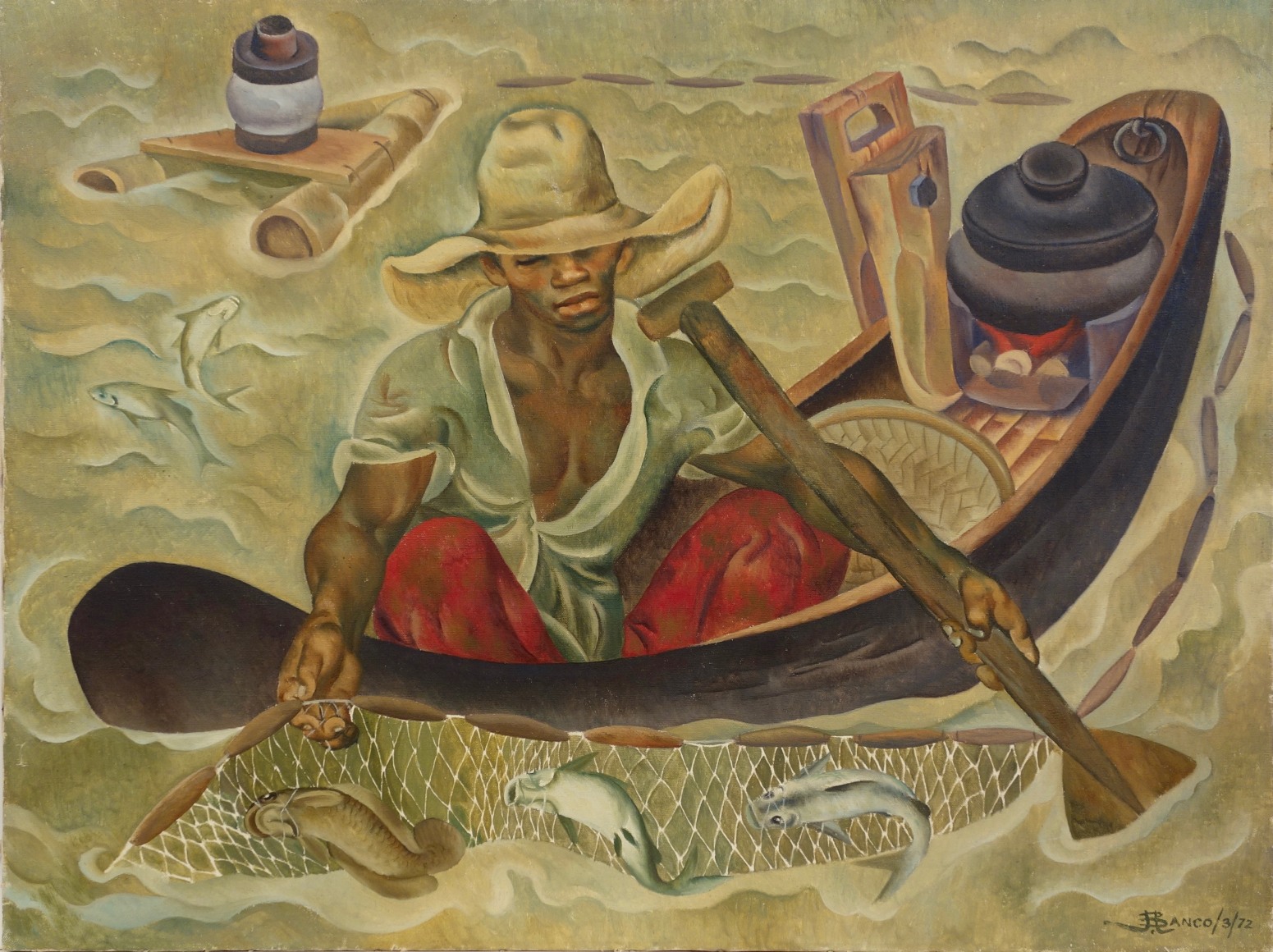Jose Blanco

Fisherman in Boat, 1972
Jose Blanco (1932 – 2008)
Jose V. Blanco, the muralist and National Artist nominee known for richly colorful and celebratory works of the Tagalog pastorale, passed away Thursday morning. The master was 76.
Blanco, whose folk realism?helped nourish a town’s artistic heritage with works spanning almost four decades, and who went on to beget a family of prolific painters, died of heart failure, according to his son Michael. The artist’s remains lie at the Bahay Blanco Family Museum at 312 Ibañez St., Angono, Rizal. Interment is on Aug. 19 after a necrological Mass at 2 p.m. at the San Clemente Parish Church, whose colorful annual fiesta Blanco celebrated continuously on his huge canvases.
Blanco’s works have been likened to that of another famous son of Angono, the late National Artist Carlos “Botong” Francisco. Blanco’s fame rests mainly on giant oils on canvas, though his work has been largely confined to the riverine town in Rizal between Laguna de Bay and the Sierra Madre mountains, some 30 kilometers outside Metro Manila.
With its romantic location and folk art traditions, the town often styles itself as the Art Capital of the Philippines. It produced, after all, two National Artists, Francisco and composer Lucio San Pedro. Nearby Binangonan town became the residence of another National Artist, painter Vicente Manansala, a Kapampangan.
“Blanco inspired and continued the legacy of Angono art”, top artist Fil Delacruz said Thursday in homage.
Featured works
Biography
Blanco, known in Angono by his folk name “Pitok Bunggan,” was part of a long line of folk artists that include Nemiranda (who did the Edsa Revolution mural at the Edsa Shrine), Perdigon Vocalan, and Juan Senson (a.k.a. Tandang Juancho), a 19th century artist regarded as the town’s ‘Grand Old Man of Art’. Blanco’s forefather Pedro Pison was a religious artist in the 19th century, while an uncle on his mother’s side became an artist after retiring from the US Navy.
Angono’s artistic tradition appears to be rooted in prehistory. The so-called Angono Petroglyphs, which were discovered in the 1960s by Francisco himself, were found to have been drawings etched on the walls of a cave deep in the town’s mountainous forest.
But while Blanco’s subjects ranged from prehistory to history, from traditional to contemporary, Blanco hewed close to Angono. It could be said that he never left Angono.
Born on March 19, 1932, he belonged to a family of fishermen who thrived on the richness of the Laguna de Bay.
And though a folk artist, Blanco was academically trained. He entered the School of Fine Arts of the University of Santo Tomas in 1951, when its faculty included the top firebrand modernists of Philippine art National Artists Victorio Edades, Manansala and Francisco, as well as Galo Ocampo, Antonio Llamas, and Diosdado Lorenzo.
While studying, Blanco still regularly went fishing in the lake to raise money for tuition.
Graduating in 1955 and topping his batch by winning the best thesis award, Blanco worked for several years as an advertising director.
In 1971, Blanco left advertising in order to paint full-time. He held his first one-man show at the Manila Hilton within the same year.
Almost instantly, Blanco became known for his murals of Angono life. The Rockefeller Foundation of New York in the 1970s acquired his Pag-ahon ng Pagoda, a depiction of the fluvial parade highlighting the feast of San Clemente, Angono’s patron saint.
Art critic Alice Guillermo called Blancos style ‘folk realism’. Notable is the graphic perspicacity of the work as well as the lushness of its earthy colors.
Perhaps the most typical of Blanco’s works is Angono Town Fiesta, a giant canvas showing more than a hundred figures in various states of delight.??The faces in the crowd are said to be based on Blanco’s actual townmates. The artist himself appears in the scene, cuddling his grandchild and pointing him to the celebration.
Despite the general optimism and festive quality of his works, Blanco did not shy away from ‘dark’ subjects. The Burning of Angono, for example, brings back his painful memory of World War II, when Japanese forces set the town ablaze in reprisal for the killing of Makapili (collaborationist) agents.
In his later years, Blanco subsumed his identity under that of his family. His seven children have long taken after him and continued the folk art tradition.
Even his wife, Loreto Perez, started to pick up the brush and became part of the ‘Blanco Family of Artists’. Just last summer, the family held a show in Xiamen, China.
Perhaps the Blancos’ most notable work is Risen Christ, a rich Eastern mural that can be viewed at the Holy Cross Parish in Valenzuela, Metro Manila.
Today Angono’s art scene remains vibrant with the opening of new galleries, adding to the established venues set up by the Blancos and Nemiranda.
But while the town’s young artists are keeping the folk tradition alive, others trained in Manila have explored new idioms, some in total collision with tradition. Those associated with the Neo-Angono Artists group, for example, seem to be taking on entirely different styles and following different masters.
Instead of Francisco and Blanco, for example, their icons are Western abstractionists such as Pollock, De Kooning, and Gerhard Richter, artists who definitely haven’t heard of Angono or its beloved Botong and Blanco.
Source:The obituary of the artist, MANILA, Philippines
Jose Blanco, Angono folk muralist, dies; 76.
By Lito Zulueta, Philippine Daily Inquirer, Posted 08/15/2008.
